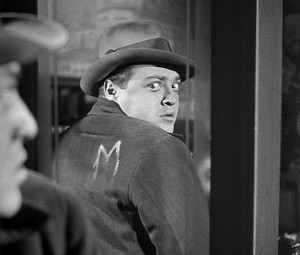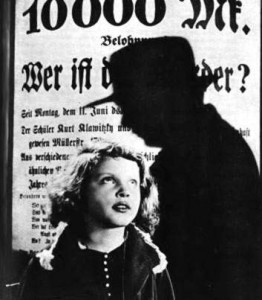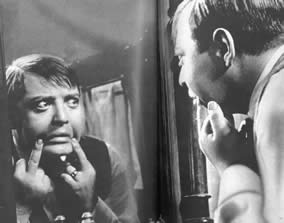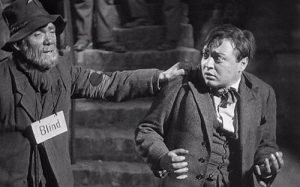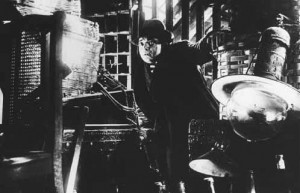100 Film Favorites – #82: M
(Fritz Lang, 1931)
This is the 19th post of the Countdown, and we’re finally to the first selection most “legitimate” film critics would approve of.
The film, which is often presented with the subtitle Eine Stadt sucht einen Mörder (“A City Searches for a Murderer”), deals with a string of grisly child murders in Berlin. Two groups work simultaneously to identify and catch the killer: the police force, and the underground forces of the city’s criminal organizations (who hate both the perverse nature of the murderer’s crimes and the increased police presence that has put a damper on their own illegal enterprises).
The format of the story is essentially a police procedural, and follows both the cops’ and the crooks’ efforts as they hunt down the “Kindmörder” (child-murderer). The killer is eventually identified as Hans Beckert, played by Peter Lorre in his first starring role.
The criminal network proves more capable than the cops (they have a network of beggars to act as eyes and ears throughout the streets), and succeed in capturing Beckert first. They haul him into an improvised “courtroom,” where the assembled criminals hold a trial. Beckert pleads that his murderous urges are beyond his control, and he is no more guilty than the other criminals, who have likewise given in to their baser instincts. The “judge and jury” disagree, and the crooks are poised to murder Beckert when the police suddenly arrive. The film ends with Beckert’s sentence being announced in a real courtroom. But before we hear the ruling, the last shot shows a victim’s mother lamenting that no sentence will bring her child back.
M (which also holds the distinction of having the shortest title on this list) was the first sound film directed by famed German director Fritz Lang, well-remembered for the silent epic Metropolis. Bearing in mind that synchronized sound in cinema was only introduced in 1927, the innovative use of sound in M is perhaps the film’s most remarkable feature. Sound is often heard from off-screen, implying a world beyond the frame in a way few films had done before. Additionally, subtle changes in volume indicate a character drawing nearer or going further away.
Another innovation is Lang’s introduction of the leitmotif in film. A leitmotif is a musical phrase associated with a character, and the tune often indicates the arrival of that character or that he or she is somewhere nearby. Leitmotifs had long been common in opera and other forms of musical theater, but M is among the first films to incorporate the concept. Beckert, the murderer, whistles “Hall of the Mountain King” when on the prowl, and the sound of his whistling indicates his whereabouts even when he is not seen. In fact, it’s his whistling which allows Beckert to be identified in the story, when a blind street vendor recognizes the whistling. This aspect of the story suggests Lang may have been trying to convey that, with the introduction of synchronized sound, viewers would now need to rely on their ears, not just their eyes, to fully understand a film’s narrative.
M also introduced the world to Peter Lorre, who spent the rest of his career largely typecast as “creepy German man” once he moved to America later in the 30s to evade the Nazis. His bugged eyes, high, wavering voice, and cringing mannerisms combine to make Lorre’s Kindmörder character very disturbing indeed.
The disturbing subject matter is another factor which makes M remarkable. A serial killer murdering children (with an implied sexual element to his crimes) is edgy even by today’s standards, and was nearly unheard of at the time. The Hollywood Production Code, introduced in 1930 and rigidly enforced beginning in 1934, strove to promote “decency” in cinema, and seriously restricted what kinds of characters and activities could be featured in movies. The enforcement of the Code starting in the mid-30s ensured that very few films addressed the same grisly subject matter as M for decades to come (though it must be admitted that M avoids showing any actual gore; Lang claimed that this restraint forces “each individual member of the audience to create the gruesome details of the murder according to his personal imagination”).
M is a classic of world cinema. Chilling, but with elements of humor (particularly in the juxtaposition of the crooks and the cops), the film is innovative in many ways. Give it a watch, but don’t hold me responsible if you find yourself compulsively whistling “Hall of the Mountain King.”
Tidbits: Both Lorre and Lang came to America after the rise of the Nazi Party in Germany compelled them to leave. Both would go on to work in the American film industry in Hollywood.
—
Brian Terrill is the host of television show Count Gauntly’s Horrors from the Public Domain. You can keep up with Brian’s 100 Film Favorites countdown here.


